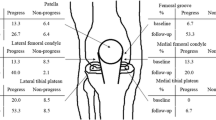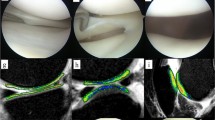Abstract
Purpose
The aim of this study was to determine the value of systemic biochemical markers of bone turnover—urine levels of cross-linked C-terminal telopeptide I (uCTX-I), urinary C-terminal telopeptide II (uCTX-II) and serum cartilage oligomeric matrix protein (sCOMP)—in the diagnosis of chondral defects after anterior cruciate ligament (ACL) rupture. Thirty-eight patients with previous ACL rupture were included.
Methods
Magnetic resonance imaging (MRI) of the injured and the intact knee joint was performed with volumetric measurement of volume and area of cartilage (VC/AC), area of subchondral bone (cAB), and area of subchondral bone denuded and eroded (dAB). Biochemical markers were measured using commercially available enzyme-linked immunoassays.
Results
MRI-based volumetric cartilage measurement showed significant differences between the injured and the intact knees. uCTX-I, sCOMP and in parts uCTX-II correlated well with MRI parameters. CTX-I showed a significant correlation with VC and AC of the whole knee joint.
Conclusions
The results suggest that uCTX-I, uCTX-II and sCOMP could identify patients with focal cartilage lesions from an early stage of osteoarthritis of the knee.
Similar content being viewed by others
References
Petersson IF, Jacobsson LT (2002) Osteoarthritis of the peripheral joints. Best Pract Res Clin Rheumatol 16:741–760
Kirwan JR, Elson CJ (2000) Is the progression of osteoarthritis phasic? Evidence and implications. J Rheumatol 27:834–836
Vignon E, Garnero P, Delmas P, Avouac B, Bettica P, Boers M, Ehrich E, MacKillop N, Rovati L, Serni U et al (2001) Recommendations for the registration of drugs used in the treatment of osteoarthritis: an update on biochemical markers. Osteoarthritis Cartilage 9:289–293
Garnero P, Rousseau JC, Delmas PD (2000) Molecular basis and clinical use of biochemical markers of bone, cartilage, and synovium in joint diseases. Arthritis Rheum 43:953–968
Bruyere O, Collette J, Kothari M, Zaim S, White D, Genant HK, Peterfy C, Burlet N, Ethgen D, Montague T et al (2006) Osteoarthritis, magnetic resonance imaging and biochemical markers: a one-year prospective study. Ann Rheum Dis 65:1050–1054
Wang Y, Ebeling PR, Hanna F, O'Sullivan R, Cicuttini FM (2005) Relationship between bone markers and knee cartilage volume in healthy men. J Rheumatol 32:2200–2204
Garnero P (2006) Use of biochemical markers to study and follow patients with osteoarthritis. Curr Rheumatol Rep 8:37–44
Bettica P, Cline G, Hart DJ, Meyer J, Spector TD (2002) Evidence for increased bone resorption in patients with progressive knee osteoarthritis: longitudinal results from the Chingford study. Arthritis Rheum 46:3178–3184
Hudelmaier M, Glaser C, Englmeier KH, Reiser M, Putz R, Eckstein F (2003) Correlation of knee-joint cartilage morphology with muscle cross-sectional areas vs. anthropometric variables. Anat Rec A Discov Mol Cell Evol Biol 270:175–184
Gandy SJ, Dieppe PA, Keen MC, Maciewicz RA, Watt I, Waterton JC (2002) No loss of cartilage volume over three years in patients with knee osteoarthritis as assessed by magnetic resonance imaging. Osteoarthritis Cartilage 10:929–937
Garnero P, Piperno M, Gineyts E, Christgau S, Delmas PD, Vignon E (2001) Cross sectional evaluation of biochemical markers of bone, cartilage, and synovial tissue metabolism in patients with knee osteoarthritis: relations with disease activity and joint damage. Ann Rheum Dis 60:619–626
Garnero P, Landewe R, Boers M, Verhoeven A, Van Der Linden S, Christgau S, Van Der Heijde D, Boonen A, Geusens P (2002) Association of baseline levels of markers of bone and cartilage degradation with long-term progression of joint damage in patients with early rheumatoid arthritis: the COBRA study. Arthritis Rheum 46:2847–2856
Takahashi M, Suzuki M, Naitou K, Miyamoto S, Kushida K (1999) Comparison of free and peptide-bound pyridinoline cross-links excretion in rheumatoid arthritis and osteoarthritis. Rheumatology (Oxford) 38:133–138
Garnero P, Mazieres B, Gueguen A, Abbal M, Berdah L, Lequesne M, Nguyen M, Salles JP, Vignon E, Dougados M (2005) Cross-sectional association of 10 molecular markers of bone, cartilage, and synovium with disease activity and radiological joint damage in patients with hip osteoarthritis: the ECHODIAH cohort. J Rheumatol 32:697–703
Davis CR, Karl J, Granell R, Kirwan JR, Fasham J, Johansen J, Garnero P, Sharif M (2005) Can biochemical markers serve as surrogates for imaging in knee osteoarthritis? Arthritis Rheum 56:4038–4047
Christgau S, Garnero P, Fledelius C, Moniz C, Ensig M, Gineyts E, Rosenquist C, Qvist P (2001) Collagen type II C-telopeptide fragments as an index of cartilage degradation. Bone 29:209–215
Reijman M, Hazes JM, Bierma-Zeinstra SM, Koes BW, Christgau S, Christiansen C, Uitterlinden AG, Pols HA (2004) A new marker for osteoarthritis: cross-sectional and longitudinal approach. Arthritis Rheum 50:2471–2478
Jordan KM, Syddall HE, Garnero P, Gineyts E, Dennison EM, Sayer AA, Delmas PD, Cooper C, Arden NK (2006) Urinary CTX-II and glucosyl-galactosyl-pyridinoline are associated with the presence and severity of radiographic knee osteoarthritis in men. Ann Rheum Dis 65:871–877
Sharif M, Kirwan J, Charni N, Sandell LJ, Whittles C, Garnero P (2007) A 5-yr longitudinal study of type IIA collagen synthesis and total type II collagen degradation in patients with knee osteoarthritis—association with disease progression. Rheumatology (Oxford) 46:938–943
Recklies AD, Baillargeon L, White C (1998) Regulation of cartilage oligomeric matrix protein synthesis in human synovial cells and articular chondrocytes. Arthritis Rheum 41:997–1006
Smith RK, Zunino L, Webbon PM, Heinegard D (1997) The distribution of cartilage oligomeric matrix protein (COMP) in tendon and its variation with tendon site, age and load. Matrix Biol 16:255–271
Neidhart M, Hauser N, Paulsson M, DiCesare PE, Michel BA, Hauselmann HJ (1997) Small fragments of cartilage oligomeric matrix protein in synovial fluid and serum as markers for cartilage degradation. Br J Rheumatol 36:1151–1160
Jung M, Christgau S, Lukoschek M, Henriksen D, Richter W (2004) Increased urinary concentration of collagen type II C-telopeptide fragments in patients with osteoarthritis. Pathobiology 71:70–76
Author information
Authors and Affiliations
Corresponding author
Rights and permissions
About this article
Cite this article
Streich, N.A., Zimmermann, D., Schmitt, H. et al. Biochemical markers in the diagnosis of chondral defects following anterior cruciate ligament insufficiency. International Orthopaedics (SICOT) 35, 1633–1637 (2011). https://doi.org/10.1007/s00264-010-1191-5
Received:
Accepted:
Published:
Issue Date:
DOI: https://doi.org/10.1007/s00264-010-1191-5




